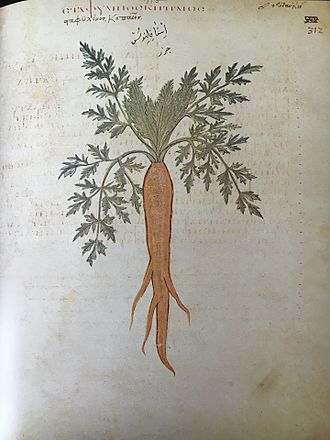
The carrot is a herbaceous biennial in the parsley family, Apiaceae, that also included celery, anise, and parsnip. It is probably native to Persia where it was cultivated for its edible seeds and leaves, but was selectively bred to decrease the bitterness and woodiness of its tap root and gradually spread into Europe. Botanical evidence suggests that some form of Dauca carota grew in ancient Pompeii and the ancient Roman naturalist, Pliny the Elder (died 90 AC), says it resembles a parsnip (a close relative). Dioscorides, a first century Greek pharmacologist and physician who traveled with Nero’s armies, recommends carrot seed to stimulate or increase menstrual flow, and for the treatment of frequent, painful urination. Photo Credit 6th Century Juliana Anicia Codex Wikipedia
As a biennial, carrot produces a rosette of leaves up to about 3′ tall in its first year and stores sugars made by the leaves in a taproot. The leaves are spirally arranged, and pinnately divided and deeply dissected into narrow segments. From June to July in the second year hairy stalks bear small umbels of tiny white flowers. Unless carrot seed is wanted the roots are harvested in the first year.
Size: 3-36″
Light: Full sun
Soil: Fertile, loose, medium moist, well-drained
USDA Hardiness Zones: 2-11